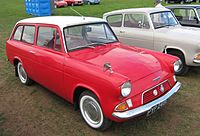
Ford Anglia 105e 1959–1968

| Ford Anglia 105E | |
|---|---|

1967 Ford Anglia 105E
|
|
| Overview | |
| Production | 1959–67 1,004,737 units |
| Assembly |
|
| Body and chassis | |
| Body style | 2-door saloon 3-door estate car 2-door panel van |
| Powertrain | |
| Engine | 997 cc (60.8 cu in) OHV I4 |
| Dimensions | |
| Wheelbase | 90.5 in (2,299 mm) |
| Length | 154 in (3,912 mm) |
| Width | 56 in (1,422 mm) |
| Height | 56 in (1,422 mm) |
| Curb weight | 1,624 lb (737 kg) (saloon) |
The fourth Anglia model, the 105E, was introduced in 1959.
Its American-influenced styling included a sweeping nose line, and on deluxe versions, a full-width slanted chrome grille in between prominent "eye" headlamps. (Basic Anglias featured a narrower, painted grille.) Its smoothly sloped line there looked more like a 1950s Studebaker (or even early Ford Thunderbird) than the more aggressive-looking late-'50s American Fords, possibly because its British designers used wind-tunnel testing and streamlining[citation needed]. Like late-'50s Lincolns and Mercurys (and later by the Citroën Ami of France and the Consul Classic), the car sported a backward-slanted rear window (so that it would remain clear in rain, according to contemporary marketing claims). In fact, this look was imported from the 1958 Lincoln Continental, where it had been the accidental result of a design specification for an electrically opening (breezeway) rear window. It had muted tailfins, much toned-down from its American counterparts. An estate car joined the saloon in the line-up in September 1961. The instrument panel had a red light for the generator and a green one for the oil pressure.
The new styling was joined by something the smaller Fords had been needing for some time, a new engine – a 997 cc overhead valve (OHV) straight-four with an oversquare cylinder bore that became known as the "Kent". Acceleration from rest was still sluggish, but it was much improved from earlier cars. Also new for British Fords was a four-speed manual gearbox with synchromesh on the top three forward ratios: this was replaced by an all-synchromesh box in September 1962 (on 1198 powered cars). The notoriously feeble vacuum-powered windscreen wipers of earlier Anglias was replaced with more conventional windscreen wipers powered by their own electric motor. The Macpherson strut independent front suspension used on the 100E was retained.
In October 1962, 24-year-old twins Tony and Michael Brookes and a group of friends took an Anglia 105E fitted with the £13 Ford Performance Kit to Montlhéry Autodrome near Paris and captured six International Class G World Records averaging 83.47 mph (134.33 km/h). These were 4,5,6 and 7 days and nights and 15,000 and 20,000 km (9,300 and 12,400 mi). The Anglia's strength and durability meant only tyre changes were required.
The car's commercial success has subsequently been overshadowed by the even greater sales achieved by the Cortina: in 1960, when 191,752 Anglias left Ford's Dagenham plant in the 105E's first full production year, it set a new production-volume record for the Ford Motor Company. From October 1963, production continued at Ford's new Halewood plant at Merseyside alongside the newly introduced Corsair models. The Anglia Super introduced in September 1962 for the 1963 model year shared the longer stroke 1198 cc version of the Ford Kent 997 cc engine of the newly introduced Ford Cortina. The Anglia Super was distinguished by its painted contrasting-coloured side stripe.
A new Anglia saloon tested by the British Motor magazine in 1959 had a top speed of 73.8 mph (118.8 km/h) and could accelerate from 0-60 mph (97 km/h) in 26.9 seconds. A fuel consumption of 41.2 miles per imperial gallon (6.86 L/100 km; 34.3 mpg‑US) was recorded. The test car cost £610 including taxes of £180.
The old 100E Anglia became the new 100E Popular and the four-door Prefect bodyshell remained available as the new Ford Prefect (107E) which had all 105E running gear, including engine and brakes, while the 100E Escort and Squire remained available, unchanged. In 1961 the Escort and Squire were replaced by the 105E Anglia estate. The 100E delivery van also gave way to a new vehicle based on the 105E. Identical to the Anglia 105E back to the B post, the rest of the vehicle was entirely new.
In South Africa, the Anglia's popularity came late. Sales really took off in early 1966, with the local introduction of the Anglia Super, and 1967 was the car's best year, with a ninth place in overall automobile registrations. Production actually continued longer in South Africa than anywhere else; it was built alongside the Escort from remaining stock until at least the end of 1968.
-

Ford Anglia 105E Estate. The basic Anglia 105E featured a smaller, painted grille with a chromed reveal, rendering it easily identifiable from the De Luxe 105E.
-

Ford Anglia 105E Estate
-

1964 Ford Anglia Van
105E-based Thames and Anglia Vans
Anglia 105E-based Thames 307E 5 cwt and 7cwt Vans were released in 1961 and were fitted with the 997cc engine from the Anglia 105E. Although they shared some front body panels with the Anglia Saloon, the vans were structurally quite different and had a taller windscreen and differently shaped side doors. Left hand drive export versions were designated Thames 308E. The Anglia name was used for certain export markets.
From October 1962 the 5 cwt and 7 cwt Vans were also offered with the 1198cc engine from the Ford Anglia Super and these were designated Thames 309E. Left hand drive export versions were designated Thames 310E.
In March 1965 the use of the Thames name was discontinued and from that time all Anglia-based vans were marketed as Ford Anglias. Production ended in November 1967 with a total of 205,001 vans having been produced.



